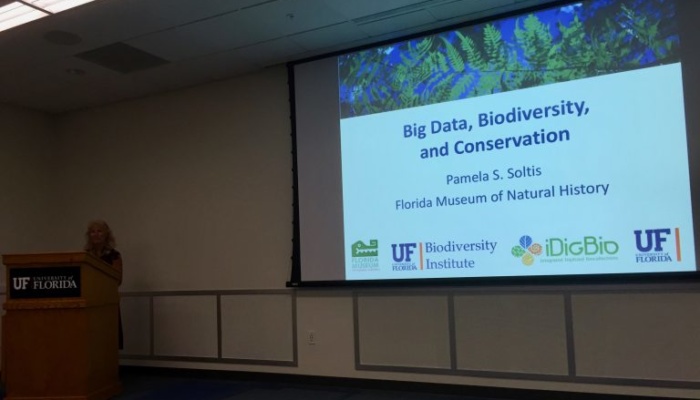Big Data, Biodiversity, and Conservation
Big Data, Biodiversity, and Conservation
By UFBI Fellow Joan Meiners
Can emerging technologies that enable the collection, distribution, and use of big data help advance research on biodiversity towards conservation goals? Earlier this week at the University of Florida, we heard from the UFBI’s own Dr. Pamela Soltis on the hidden but significant role museum specimens, iDigBio, and citizen science can play towards protecting our global biodiversity.
Biodiversity, which Dr. Soltis defines as the totality of life on earth, includes not only the described species we can see and count, but all those species we have yet to describe, the microbes that live on and in and around all of us, and the vast genetic diversity that make up all these lifeforms. Much is left to be discovered. But there is also a wealth of biodiversity information that has already been collected and cataloged into museums, and serve as valuable time capsules of information about the state of biodiversity at various points in our global history. As the world continues to rapidly change, and biodiversity experiences new and increasing threats from urbanization, invasive species, and environmental change, these collections may prove increasingly useful as repositories of knowledge about the expansive biodiversity on our planet we must take action to protect.


There are over 1600 natural history collections in the U.S. alone, which Dr. Pam Soltis estimates house between 1-2 billion specimens. The second largest of these collections is actually right here at the University of Florida. Dr. Soltis and her colleagues at the Florida Museum of Natural History are making use of natural history collections data in their own research projects, asking questions  about how the distribution of Flo
about how the distribution of Flo rida plants might change under future projected climate scenarios based on their known past and current locations throughout the state. Results like these aid biodiversity conservation efforts by allowing managers to predict future habitat suitability and develop plans for the plants and animals that may need protection if their suitable habitat is predicted to shrink.
rida plants might change under future projected climate scenarios based on their known past and current locations throughout the state. Results like these aid biodiversity conservation efforts by allowing managers to predict future habitat suitability and develop plans for the plants and animals that may need protection if their suitable habitat is predicted to shrink.
For many researchers not working next door to world-renowned collections, however, making progress on biodiversity and conservation-related research can be hampered by the fact that most of the world’s 3-4 billion museum specimens are still locked away in cabinets. To deal with this problem, and bring biodiversity research and conservation into the big data era, Dr. Soltis is also working to share the wealth and make collections data accessible to other researchers through a National Science Foundation-funded project to integrate and digitize biodiversity collections, called iDigBio. They are coordinating efforts to digitize natural history specimens, put the collections information online, and link these data resources with other databases of phylogeny, genetic, ecological, and paleontological information (like NEON). To accomplish this, iDigBio is working directly with museums as well as tapping into the network of citizen scientists we have discussed the past two weeks in posts here on the UF Biodiversity Blog. Using the Notes from Nature site, developed in part by UF researcher and Florida Museum Associate Curator Dr. Rob Guralnick, citizen scientists can log in from home to help transcribe museum specimens labels and increase the amount of natural history data available to all those interested in tapping into our global knowledge to understand and conserve biodiversity. It is through collaborative, integrative efforts like this from both innovative scientists and eager citizens that we will have the best chance of recognizing and protecting global biodiversity in the face of unprecedented challenges, using the big data just waiting to be accessed in natural history collections.
Contributed by Joan Meiners, UFBI Graduate Research Fellow. Follow @beecycles. More at www.sixlegsonecorolla.wordpress.com.


